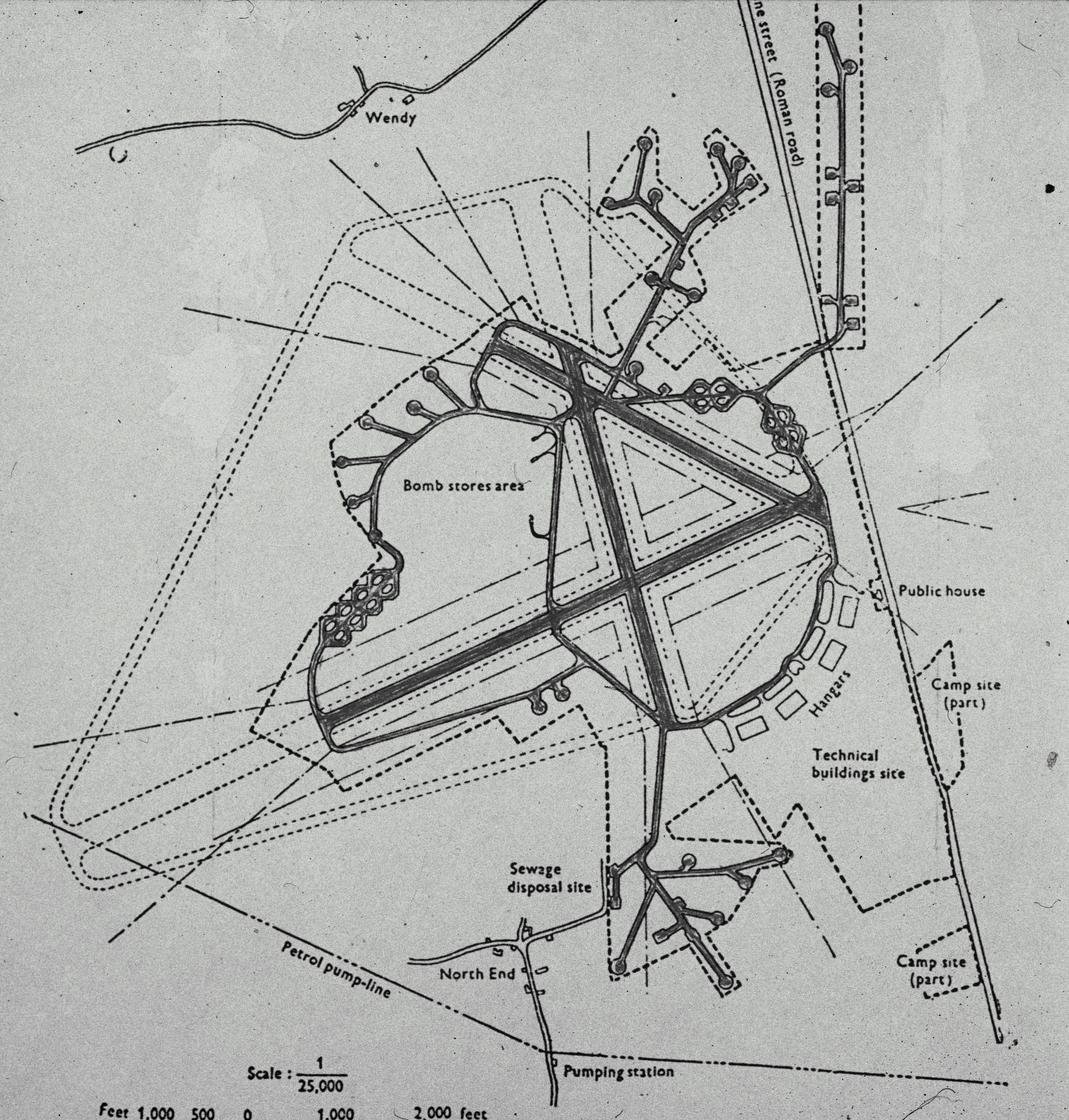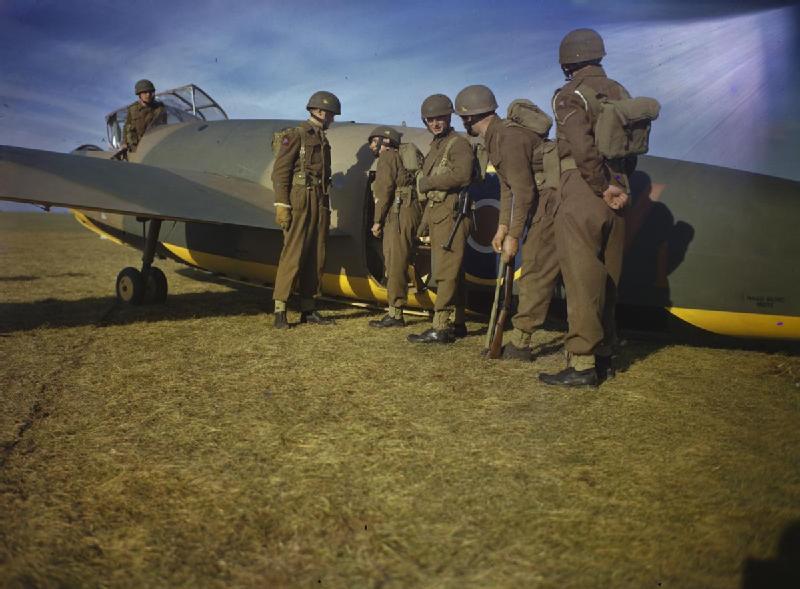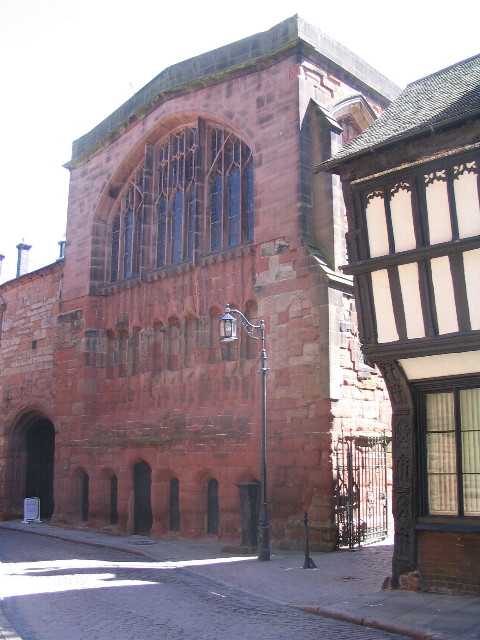|
RAF Wellesbourne Mountford
Wellesbourne Mountford Airfield (ICAO:EGBW) is located in Wellesbourne, Warwickshire, England, east of Stratford-upon-Avon. The airfield was formerly the Royal Air Force station RAF Wellesbourne Mountford. Wellesbourne Mountford is best known for its role in the Second World War, when it was under control by RAF Bomber Command as an Operational Training Unit training crews from within the commonwealth and other countries. Today the airfield has a CAA Ordinary Licence (Number P681) that allows flights for the public transport of passengers or for flying instruction as authorised by the licensee (Radarmoor Limited). It is primarily a general aviation (GA) airfield; see UKGA for details. Wellesbourne Mountford is also home to Avro Vulcan XM655, which is kept in taxiable condition. History of the airfield Royal Air Force use The airfield was originally opened in 1941 constructed in the typical Class A airfield design, the main unit to use the airfield was No. 22 Operational T ... [...More Info...] [...Related Items...] OR: [Wikipedia] [Google] [Baidu] |
Avro Vulcan
The Avro Vulcan (later Hawker Siddeley Vulcan from July 1963) is a jet-powered, tailless, delta-wing, high-altitude, strategic bomber, which was operated by the Royal Air Force (RAF) from 1956 until 1984. Aircraft manufacturer A.V. Roe and Company ( Avro) designed the Vulcan in response to Specification B.35/46. Of the three V bombers produced, the Vulcan was considered the most technically advanced, hence the riskiest option. Several reduced-scale aircraft, designated Avro 707s, were produced to test and refine the delta-wing design principles. The Vulcan B.1 was first delivered to the RAF in 1956; deliveries of the improved Vulcan B.2 started in 1960. The B.2 featured more powerful engines, a larger wing, an improved electrical system, and electronic countermeasures, and many were modified to accept the Blue Steel missile. As a part of the V-force, the Vulcan was the backbone of the United Kingdom's airborne nuclear deterrent during much of the Cold War. Although th ... [...More Info...] [...Related Items...] OR: [Wikipedia] [Google] [Baidu] |
Class A Airfield
Class A airfields were World War II military installations constructed to specifications laid down by the British Air Ministry Directorate-General of Works (AMDGW). Intended for use by heavy bombers and transports, they were the standard air base design for the Royal Air Force as well as U.S. Army Air Forces units operating from the UK. Upon the entry of the US into the war a number of RAF Class A bases were transferred to the U.S. Eighth Air Force for use as heavy bomber bases with the RAF units formerly occupying them being redeployed to other RAF bomber airfields, and U.S. Army Engineer Units constructed more airfields to this standard or brought earlier airfields up to this specification by lengthening runways, etc. Many units of the U.S. Ninth Air Force also flew from Class A airfields. The term Class 'A' came about because, quite often, the resultant aerial shot of the crossed runways would look like the letter A. Design The specifications set by the British Air Ministr ... [...More Info...] [...Related Items...] OR: [Wikipedia] [Google] [Baidu] |
RAF School Of Education
The Royal Air Force (RAF) is the United Kingdom's air and space force. It was formed towards the end of the First World War on 1 April 1918, becoming the first independent air force in the world, by regrouping the Royal Flying Corps (RFC) and the Royal Naval Air Service (RNAS). Following the Allied victory over the Central Powers in 1918, the RAF emerged as the largest air force in the world at the time. Since its formation, the RAF has taken a significant role in British military history. In particular, it played a large part in the Second World War where it fought its most famous campaign, the Battle of Britain. The RAF's mission is to support the objectives of the British Ministry of Defence (MOD), which are to "provide the capabilities needed to ensure the security and defence of the United Kingdom and overseas territories, including against terrorism; to support the Government's foreign policy objectives particularly in promoting international peace and security". The RA ... [...More Info...] [...Related Items...] OR: [Wikipedia] [Google] [Baidu] |
Defence School Of Photography
The Defence School of Photography (DSoP) is a training centre for all photographers drawn from the three arms of the British Military and the Civil Service.The Royal Marines are part of the Royal Navy. The School has been located at RAF Cosford in Shropshire, England since 1963 and in its own purpose built building at Cosford since 1965. The school has gone through several iterations being firstly a Royal Flying Corps school, then a Royal Air Force School, then a Joint school before becoming the DSoP in 2003. Its origins lie in the advent of the First World War, with training being developed as far back as 1912; the school lays claim to being the oldest technical training environment in the Royal Air Force, pre-dating the formation of the RAF itself. In 2003, the school was renamed as the Defence School of Photography which widened the scope on training it could offer across governmental agencies. Since 2006 it has been under the command and control of the Defence Intelligence ... [...More Info...] [...Related Items...] OR: [Wikipedia] [Google] [Baidu] |
General Aircraft Hotspur
The General Aircraft GAL.48 Hotspur was a military glider designed and built by the British company General Aircraft Ltd during World War II. When the British airborne establishment was formed in 1940 by order of Prime Minister Winston Churchill, it was decided that gliders would be used to transport airborne troops into battle. General Aircraft Ltd were given a contract by the Ministry of Aircraft Production in June 1940 to design and produce an initial glider for use by the airborne establishment, which resulted in the Hotspur. Conceived as an "assault" glider which necessitated a compact design and no more than eight troops carried, tactical philosophy soon favoured larger numbers of troops being sent into battle aboard gliders. Due to this, the Hotspur was mainly relegated to training where it did excel and it became the basic trainer for the glider schools that were formed.Munson 1972, p. 199. The Hotspur was named after Sir Henry Percy, a significant captain during the ... [...More Info...] [...Related Items...] OR: [Wikipedia] [Google] [Baidu] |
Bremen
Bremen (Low German also: ''Breem'' or ''Bräm''), officially the City Municipality of Bremen (german: Stadtgemeinde Bremen, ), is the capital of the Germany, German States of Germany, state Bremen (state), Free Hanseatic City of Bremen (''Freie Hansestadt Bremen''), a two-city-state consisting of the cities of Bremen and Bremerhaven. With about 570,000 inhabitants, the Hanseatic League, Hanseatic city is the List of cities in Germany by population, 11th largest city of Germany and the second largest city in Northern Germany after Hamburg. Bremen is the largest city on the River Weser, the longest river flowing entirely in Germany, lying some upstream from its River mouth, mouth into the North Sea, and is surrounded by the state of Lower Saxony. A commercial and industrial city, Bremen is, together with Oldenburg (city), Oldenburg and Bremerhaven, part of the Bremen/Oldenburg Metropolitan Region, with 2.5 million people. Bremen is contiguous with the Lower Saxon towns of Delmenhor ... [...More Info...] [...Related Items...] OR: [Wikipedia] [Google] [Baidu] |
Essen
Essen (; Latin: ''Assindia'') is the central and, after Dortmund, second-largest city of the Ruhr, the largest urban area in Germany. Its population of makes it the fourth-largest city of North Rhine-Westphalia after Cologne, Düsseldorf and Dortmund, as well as the ninth-largest city of Germany. Essen lies in the larger Rhine-Ruhr Metropolitan Region and is part of the cultural area of Rhineland. Because of its central location in the Ruhr, Essen is often regarded as the Ruhr's "secret capital". Two rivers flow through the city: in the north, the Emscher, the Ruhr area's central river, and in the south, the Ruhr River, which is dammed in Essen to form the Lake Baldeney (''Baldeneysee'') and Lake Kettwig (''Kettwiger See'') reservoirs. The central and northern boroughs of Essen historically belong to the Low German ( Westphalian) language area, and the south of the city to the Low Franconian (Bergish) area (closely related to Dutch). Essen is seat to several of the re ... [...More Info...] [...Related Items...] OR: [Wikipedia] [Google] [Baidu] |
Cologne
Cologne ( ; german: Köln ; ksh, Kölle ) is the largest city of the German western state of North Rhine-Westphalia (NRW) and the fourth-most populous city of Germany with 1.1 million inhabitants in the city proper and 3.6 million people in the urban region. Centered on the left (west) bank of the Rhine, Cologne is about southeast of NRW's state capital Düsseldorf and northwest of Bonn, the former capital of West Germany. The city's medieval Catholic Cologne Cathedral (), the third-tallest church and tallest cathedral in the world, constructed to house the Shrine of the Three Kings, is a globally recognized landmark and one of the most visited sights and pilgrimage destinations in Europe. The cityscape is further shaped by the Twelve Romanesque churches of Cologne, and Cologne is famous for Eau de Cologne, that has been produced in the city since 1709, and "cologne" has since come to be a generic term. Cologne was founded and established in Germanic ... [...More Info...] [...Related Items...] OR: [Wikipedia] [Google] [Baidu] |
Ettington Railway Station
Ettington railway station was a railway station that served the village of Ettington in Warwickshire, England. History Opened on 1 July 1873 the station was situated on the East and West Junction Railway route from Stratford-upon-Avon to Fenny Compton. The station had two platforms with a passing loop for the otherwise single line. Its buildings were of brick and to a design virtually standard for the line. There was a small waiting shelter on the down platform, access to which was by a barrow crossing. There were three sidings including one each to the goods shed and cattle pens. Four years after opening the station had its passenger service withdrawn due to lack of business. An extension to Broom Junction was incorporated in 1873 by means of a railway called the Evesham Redditch and Stratford-upon-Avon Junction Railway which opened in 1879. As trade picked up, the station was reopened on 22 February 1885. The line became part of the Stratford-upon-Avon and Midland Junct ... [...More Info...] [...Related Items...] OR: [Wikipedia] [Google] [Baidu] |
Birmingham
Birmingham ( ) is a city and metropolitan borough in the metropolitan county of West Midlands in England. It is the second-largest city in the United Kingdom with a population of 1.145 million in the city proper, 2.92 million in the West Midlands metropolitan county, and approximately 4.3 million in the wider metropolitan area. It is the largest UK metropolitan area outside of London. Birmingham is known as the second city of the United Kingdom. Located in the West Midlands region of England, approximately from London, Birmingham is considered to be the social, cultural, financial and commercial centre of the Midlands. Distinctively, Birmingham only has small rivers flowing through it, mainly the River Tame and its tributaries River Rea and River Cole – one of the closest main rivers is the Severn, approximately west of the city centre. Historically a market town in Warwickshire in the medieval period, Birmingham grew during the 18th century during the M ... [...More Info...] [...Related Items...] OR: [Wikipedia] [Google] [Baidu] |
Coventry
Coventry ( or ) is a city in the West Midlands, England. It is on the River Sherbourne. Coventry has been a large settlement for centuries, although it was not founded and given its city status until the Middle Ages. The city is governed by Coventry City Council. Formerly part of Warwickshire until 1451, Coventry had a population of 345,328 at the 2021 census, making it the tenth largest city in England and the 12th largest in the United Kingdom. It is the second largest city in the West Midlands region, after Birmingham, from which it is separated by an area of green belt known as the Meriden Gap, and the third largest in the wider Midlands after Birmingham and Leicester. The city is part of a larger conurbation known as the Coventry and Bedworth Urban Area, which in 2021 had a population of 389,603. Coventry is east-south-east of Birmingham, south-west of Leicester, north of Warwick and north-west of London. Coventry is also the most central city in Englan ... [...More Info...] [...Related Items...] OR: [Wikipedia] [Google] [Baidu] |
Midlands
The Midlands (also referred to as Central England) are a part of England that broadly correspond to the Mercia, Kingdom of Mercia of the Early Middle Ages, bordered by Wales, Northern England and Southern England. The Midlands were important in the Industrial Revolution of the 18th and 19th centuries. They are split into the West Midlands (region), West Midlands and East Midlands. The region's biggest city, Birmingham often considered the social, cultural, financial and commercial centre of the Midlands, is the second-largest city and List of metropolitan areas in the United Kingdom, metropolitan area in the United Kingdom. Symbolism A saltire (diagonal cross) may have been used as a symbol of Mercia as early as the reign of Offa. By the 13th century, the saltire had become the attributed arms of the Kingdom of Mercia. The coat of arms, arms are blazoned ''Azure, a saltire Or'', meaning a gold (or yellow) saltire on a blue field. The saltire is used as both a flag and a coat of ... [...More Info...] [...Related Items...] OR: [Wikipedia] [Google] [Baidu] |









